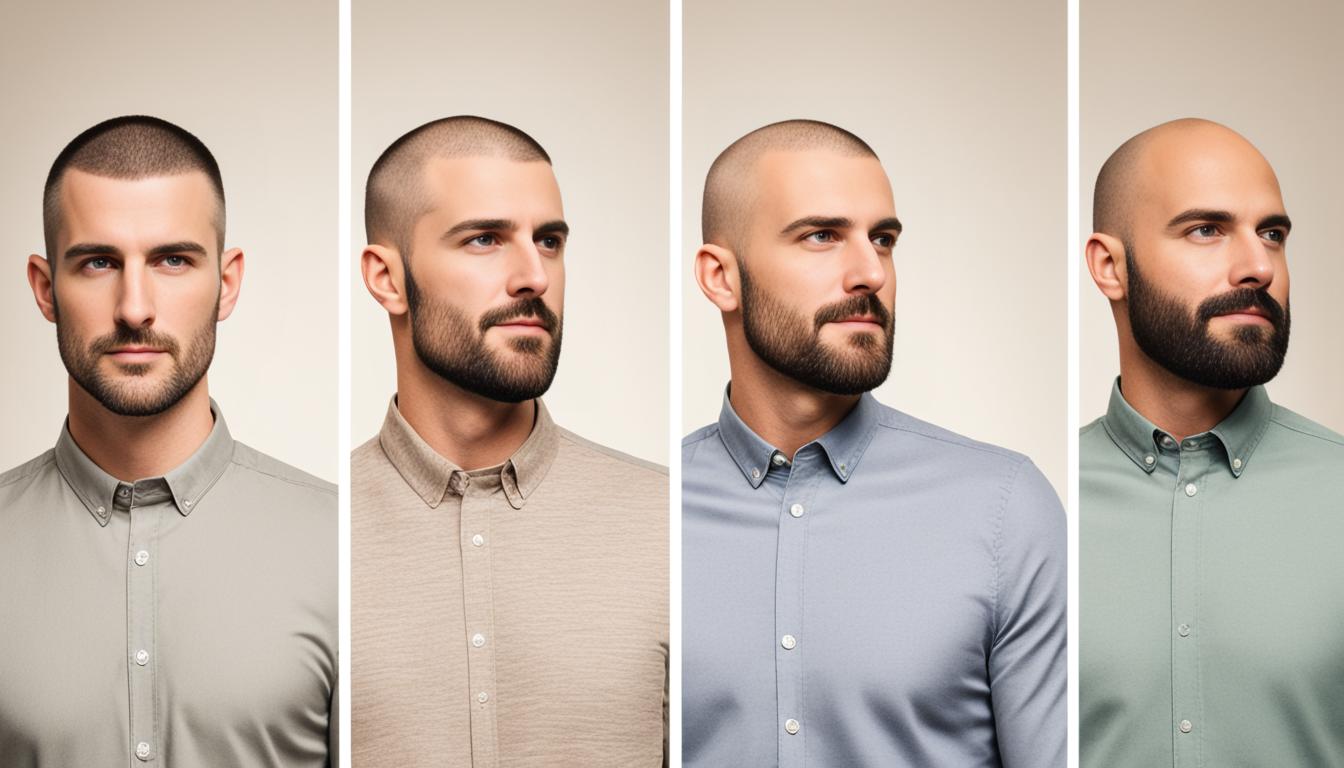Have you ever wondered how long it takes for your hair to grow? Understanding the hair growth timeline can help you set realistic expectations and take better care of your locks. On average, hair grows about half an inch per month, which means you can expect roughly 1.5 inches of growth in three months. However, it’s important to note that the rate of hair growth can vary from person to person.
The average person’s hair grows for about six years before falling out, and around 100 hairs are naturally shed each day. Hair growth occurs in different stages, including the anagen phase (active growth), catagen phase (transition), telogen phase (resting), and exogen phase (shedding). Each hair follicle goes through this cycle about 10-30 times in a person’s lifetime. The rate of hair growth can also be influenced by factors such as age, genetics, overall health, medical conditions, hormonal changes, and stress.
Understanding the factors that affect hair growth rate can help you take better care of your mane. Genetics play a significant role, with individuals of different ethnicities having varying hair densities. The hair growth cycle, consisting of different stages, can also impact the overall growth rate. Hormonal changes, certain medical conditions, medications, and nutritional deficiencies can affect hair growth as well.
While you may not be able to significantly alter the natural rate of your hair growth, there are some tips you can follow to potentially speed up the process. Taking care of your scalp, maintaining a balanced diet, reducing stress, and using products that promote hair health can all contribute to healthier and potentially faster growth.
The process of hair regrowth involves revitalizing the hair follicles responsible for producing new strands. Proper scalp care, nutrition, and avoiding damage to the hair shaft are crucial for promoting healthy regrowth. Various treatments, such as topical solutions, platelet-rich plasma therapy, and supplements, can help stimulate hair follicles and kick-start the growth process. It is always advisable to consult a healthcare professional for a personalized plan.
After experiencing hair loss, factors such as pattern baldness, alopecia areata, scalp psoriasis, hormonal changes, and nutritional deficiencies can affect hair regrowth. The process and timeline for regrowth may vary depending on the underlying cause. Seeking medical advice and following a customized treatment plan can optimize regrowth.
In conclusion, understanding the factors that affect hair growth and taking care of your mane can contribute to optimal hair growth outcomes. While the natural rate of growth may vary, a healthy hair care routine, good nutrition, and addressing underlying issues can help you achieve the best possible results. So, be patient, take care of your hair, and enjoy the journey to longer, healthier locks!
Factors Affecting Hair Growth Rate
Understanding the factors that affect hair growth rate is essential for promoting healthy hair growth. There are several key elements that contribute to the speed at which hair grows.
1. Hair Growth Cycle Stages
The hair growth cycle consists of four stages: anagen, catagen, telogen, and exogen. Each stage plays a crucial role in determining the overall growth rate.
- The anagen phase is the active growth phase, where hair follicles produce new hair. It typically lasts for 2-7 years, and the longer this phase lasts, the longer the hair can grow.
- The catagen phase is a transitional phase that lasts for about 2-3 weeks. Hair follicles shrink during this phase, preparing for the next stage.
- The telogen phase is a resting phase that lasts for around 2-3 months. During this stage, hair follicles remain dormant before shedding the old hair and entering the next growth cycle.
- The exogen phase is the shedding phase, where old hair is actively shed to allow new hair to grow.
Understanding these stages helps to grasp the natural progression of hair growth and the factors that can impact its rate.
2. Hair Growth Rate Genetics
Genetics play a crucial role in determining hair growth rate. Different ethnicities have varying hair densities and growth rates, which can be attributed to genetic factors. Some individuals naturally have faster hair growth rates, while others may experience slower growth.
While genetic factors cannot be changed, understanding these dynamics helps individuals set realistic expectations for their hair growth journey.
3. Promoting Healthy Hair Growth
To promote healthy hair growth, it is essential to take care of your hair and scalp. This includes maintaining a balanced diet, reducing stress levels, and using proper hair care techniques.
Nutritional deficiencies, certain medical conditions, medications, and hormonal changes can impact hair growth. Eating a nutritious diet rich in vitamins, minerals, and proteins can support healthy follicle function and promote hair growth.
Additionally, minimizing heat styling, avoiding harsh chemical treatments, and practicing good scalp hygiene can help maintain the health of hair follicles, facilitating optimal growth.
| Factors Affecting Hair Growth Rate | Description |
|---|---|
| Genetics | Different ethnicities have varying hair densities and growth rates. |
| Hair Growth Cycle Stages | Consists of four stages: anagen, catagen, telogen, and exogen. |
| Nutrition | A balanced diet rich in vitamins, minerals, and proteins supports healthy hair growth. |
| Stress | High stress levels can impact hair growth. |
| Hormonal Changes | Pregnancy, menopause, and other hormonal fluctuations can affect hair growth. |
| Medical Conditions | Certain conditions and medications can impact hair growth. |
By considering these factors and taking proactive steps to foster a healthy hair care routine, individuals can optimize their hair growth potential.

Tips to Speed Up Hair Growth
The rate at which hair grows is largely determined by factors beyond our control. However, there are several tips and practices that can potentially maximize hair growth potential and promote faster, healthier hair growth.
1. Maintain a Healthy Diet
A healthy diet plays a crucial role in promoting hair growth. Consuming a balanced mix of essential vitamins and minerals can provide the necessary nutrients for healthy hair. Include foods that are rich in vitamins A, C, and E, as well as B vitamins and biotin. These nutrients support the production of keratin, the protein that makes up hair strands, and help maintain a healthy scalp. Incorporate foods like leafy green vegetables, eggs, fish, nuts, and seeds into your diet to promote faster hair growth.
2. Avoid Harsh Styling Practices
Excessive heat, chemical treatments, and tight hairstyles can cause damage to the hair shaft, leading to breakage and slower growth. Minimize the use of heat-styling tools like flat irons and curling rods, and opt for heat-protectant products when necessary. Additionally, avoid over-processing your hair with chemical treatments like relaxers and perms. Instead, embrace more gentle styling techniques and protective hairstyles that minimize tension on the hair, such as braids, twists, and buns.
3. Use Products that Promote Hair Health
Choosing the right hair care products can make a significant difference in promoting faster hair growth. Look for shampoos and conditioners that are formulated to strengthen and nourish the hair. Products containing ingredients like biotin, keratin, and essential oils can help maximize hair growth potential and improve overall hair health. Additionally, consider incorporating a leave-in conditioner or hair serum into your routine for added hydration and protection.

4. Regular Scalp Massages
Scalp massages can help improve blood circulation to the hair follicles, thereby potentially stimulating hair growth. Gently massage your scalp in circular motions using your fingertips or a soft-bristle brush. This practice not only promotes blood flow but also helps distribute natural oils and nutrients throughout the scalp, keeping the hair follicles healthy and nourished.
5. Protect from Excessive Heat and Sunlight
Excessive heat from styling tools and prolonged exposure to sunlight can cause damage to the hair cuticle, leading to dryness, breakage, and slower growth. Invest in heat-protectant sprays and serums to shield your hair from high temperatures and use hats or scarves to protect your hair from the sun’s harmful UV rays. Additionally, aim to minimize direct heat exposure by allowing your hair to air-dry whenever possible.
By incorporating these tips into your hair care routine, you can promote faster hair growth, maximize your hair growth potential, and achieve healthier, more luscious locks.
How Long Does It Take for Your Hair to Grow?
The process of hair regrowth involves revitalizing the hair follicles, which are responsible for producing new hair strands. To promote healthy hair growth and revitalize the follicles, it’s essential to maintain a healthy scalp, practice proper nutrition, and avoid damage to the hair shaft.
One crucial factor in the hair regrowth process is maintaining a healthy scalp. A clean and well-nourished scalp provides the ideal environment for hair follicles to thrive. Regularly washing your hair with a gentle shampoo and conditioner can help remove dirt, excess oil, and product buildup, promoting a healthy scalp and optimal conditions for hair regrowth.
Proper nutrition is another critical aspect of promoting healthy hair growth. Nutrients such as vitamins A, C, D, E, and Biotin play a significant role in supporting hair follicle health and stimulating hair growth. Including a balanced diet rich in fruits and vegetables, lean proteins, whole grains, and healthy fats can ensure you provide your body with the essential nutrients it needs for healthy hair regrowth.
Avoiding damage to the hair shaft is equally important for promoting hair regrowth. Excessive heat styling, chemical treatments, and aggressive brushing or combing can lead to hair breakage and damage to the hair follicles. To minimize damage, it’s recommended to use heat-protectant products before styling, opt for gentle styling techniques, and avoid tight hairstyles that can cause tension on the hair strands.
Various methods can stimulate hair follicles and kickstart the regrowth process. Topical treatments, such as minoxidil, can be applied directly to the scalp to promote hair regrowth. Platelet-rich plasma (PRP) therapy involves injecting the patient’s own platelet-rich plasma into the scalp, which can stimulate hair follicles. Additionally, certain supplements, such as biotin or collagen, may provide nutritional support for hair regrowth when used as part of a comprehensive treatment plan.
When experiencing hair loss or seeking to promote hair regrowth, it’s crucial to consult a healthcare professional specializing in hair loss and restoration. They can assess the underlying cause of hair loss, determine the most effective treatment options, and develop a personalized plan tailored to your specific needs and goals.

| Promoting Healthy Hair Regrowth | Methods |
|---|---|
| Maintain a healthy scalp | Regularly wash hair with gentle shampoo and conditioner |
| Eat a balanced diet | Incorporate nutrient-rich foods such as fruits, vegetables, lean proteins, whole grains, and healthy fats |
| Avoid damaging the hair shaft | Use heat-protectant products, practice gentle styling techniques, and avoid tight hairstyles |
| Utilize topical treatments | Apply minoxidil or other recommended treatments directly to the scalp |
| Consider platelet-rich plasma (PRP) therapy | Inject the patient’s own platelet-rich plasma into the scalp to stimulate hair follicles |
| Supplement with recommended nutrients | Include biotin or collagen supplements as part of a comprehensive treatment plan |
Factors Affecting Hair Growth After Hair Loss
The regrowth of hair after experiencing hair loss can be influenced by various factors. One common cause of hair loss is pattern hair loss, where the hair follicles gradually stop producing new hair. This can make the regrowth process more challenging for individuals affected by this condition.
Alopecia areata, another common cause of hair loss, can also affect regrowth. This autoimmune condition causes the immune system to mistakenly attack hair follicles, resulting in hair loss. Regrowth after alopecia areata can be unpredictable and may vary from person to person.
Hormonal changes can also play a role in hair growth after loss. For example, during pregnancy and menopause, hormonal fluctuations can impact the hair growth cycle and result in temporary shedding. Once hormone levels stabilize, regrowth can occur.
In some cases, an underlying medical condition, such as scalp psoriasis, can interfere with hair regrowth. Scalp psoriasis is a chronic autoimmune disease that causes red, scaly patches on the scalp and can lead to hair loss. Proper treatment and management of the condition can promote regrowth.
Nutritional deficiencies can also affect hair regrowth. Inadequate intake of essential vitamins and minerals, such as iron, zinc, and biotin, can contribute to hair loss and slow regrowth. A balanced diet and nutritional supplementation can help support healthy hair growth.
Additionally, the regrowth process after chemotherapy can vary from person to person. Generally, regrowth occurs within a few weeks to several months after completing chemotherapy treatment. The timing and speed of regrowth depend on various factors, including the type of chemotherapy drugs used and the individual’s overall health.
To determine the underlying cause of hair loss and develop an appropriate treatment plan for regrowth, it’s essential to seek medical advice. A healthcare professional can provide personalized guidance based on the individual’s specific condition and needs.
Conclusion
The rate of hair growth is influenced by factors such as genetics, overall health, and hormonal changes. While it may not be possible to significantly alter the natural rate of hair growth, maintaining a healthy hair care routine and minimizing damage can support optimal growth.
Promoting healthy hair growth starts with a balanced diet rich in essential vitamins and minerals. Avoiding excessive heat and chemicals, practicing good scalp hygiene, and protecting the hair from environmental stressors are also important.
For individuals experiencing hair loss, it is recommended to seek medical advice and follow a customized treatment plan to promote regrowth. Addressing any underlying issues and taking care of your hair can contribute to the best possible hair growth outcomes. Remember, a healthy hair care routine is key to maintaining and promoting hair regrowth.




